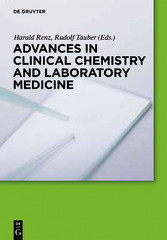Search and Find
Service
Preface
5
1 Plenary Articles
19
1.1 Proteomics strategies targeting biomarkers for cardiovascular disease
21
1.2 Influence of pre-examination aspects on result’s validity – are ISO 15189 requirements sufficient and clear?
27
1.3 Posttranslational modifications in tumor diagnosis
30
1.4 Chronic inflammatory disease: a result of complex gene-environment interaction
34
2 Symposium Articles
39
2.1 Component-array technology diagnostics: a step forward in the study of the sensitization profile of allergic patients
41
2.2 Pediatric metabolic syndrome: pathophysiology and molecular mechanisms
44
2.3 Urinary 8-hydroxydeoxyguanosine as a biomarker of microangiopathic complications in type 2 diabetic patients
48
2.4 Biological variation data: the need for appraisal of the evidence base
53
2.5 RecoveryELISA - a newly developed immunoassay for measurement of therapeutic antibodies and the target antigen during antibody therapy
56
2.6 Genotypic prediction of HIV-1 tropism from plasma and peripheral blood mononuclear cells in the clinical routine laboratory
60
2.7 Expression of a subset of microRNAs in clinically non-functioning pituitary adenomas correlates with tumor size
64
2.8 Serological markers of gastric pathology
68
2.9 BNP as a biomarker of cardiac impairment in neonates with congenital heart diseases
72
2.10 Are 25-hydroxyvitamin D assays fit for purpose?
76
2.11 Update on multiple sclerosis
79
2.12 Microalbuminuria and urinary retinol binding protein as markers of subtle renal injury in visceral leishmaniasis: sensitivity, specificity and predictive values of the immunoturbidimetric technique
83
2.13 Occult hepatitis B virus infection: diagnosis and significance
86
2.14 Unmet needs in chronic kidney disease testing
90
2.15 Towards a national chronic kidney disease testing program
93
2.16 Biochemistry and metabolism of vitamin D
96
2.17 Diagnostics of thalassemia
100
2.18 The specific roles of assessors during accreditation
103
2.19 Laboratory diagnosis of hereditary spherocytosis
106
2.20 Quantification of blood folate forms using stable-isotope dilution ultra performance liquid chromatography tandem mass spectrometry
109
2.21 Evaluation of the new Marburg cerebrospinal fluid model with human spondylopathies
113
2.22 E-learning experiences of national societies of clinical chemistry and laboratory medicine
117
2.23 The experience of Médecins Sans Frontières in laboratory medicine in resource-limited settings
120
2.24 Screening, identifying, and quantifying small molecules by hyphenated mass spectrometry in toxicology and drug monitoring – an update
126
2.25 Analytical quality in the Latin America area
129
2.26 Standardization in molecular diagnostics: definitions and uses of nucleic acid reference materials
134
2.27 Profiling of antiphospolipid antibodies – association with cerebrovascular events in APS
138
2.28 Plasma levels of soluble CD30 and CD40L in pediatric patients after liver transplantation
142
2.29 Diagnostic and prognostic value of presepsin (soluble CD14 subtype) in emergency patients with early sepsis using the new assay PATHFAST presepsin
146
2.30 Diagnostic workup of primary aldosteronism
152
2.31 What should the clinical laboratory and the toxicologist-pharmacologist offer the poisoned patient?
156
2.32 Novel aspects of von Willebrand factor – platelet glycoprotein IB interaction and signaling
160
2.33 Medical emergencies: what is the laboratory’s role?
161
All prices incl. VAT












